Modelling of Amino Acid Fermentations and Stabilization of Anaerobic Digestates by Extracting Ammonium Bicarbonate
IF 3.3
3区 农林科学
Q2 BIOTECHNOLOGY & APPLIED MICROBIOLOGY
引用次数: 0
Abstract
With the current increase in demand for animal and agricultural products, management of agrowaste has become critical to avoid greenhouse gas emissions. The present article investigates the applicability of ammonium bicarbonate synthesis via flash distillation to valorize and stabilize several types of anaerobic digestates which are produced from individual fermentations of amino acids. The content of CO2 in the digestate was found to be responsible for the OH alkalinity (0.4 equivalents of acid/kg digestate), while the partial and total alkalinities (0.8 eq/kg digestate) were essentially derived from the content of NH3. The most suitable conditions for the flash distillation were 95 °C and 1 bar with the condensation occurring at 25 °C. However, in order to attain the precipitation of NH4HCO3 in the distillate, it was necessary to consider digestates with a moisture content of 50 wt.%, since saturation levels of inorganic nitrogen and inorganic carbon were not attained otherwise. Even under these conditions, few amino acids (i.e., arginine, glycine, and histidine) were able to provide an anaerobic digestate upon fermentation that would be suitable for NH4HCO3 stabilization. The process of stabilization with a capacity of a t of digestate per h was improved by adding hydrochloric acid or sodium hydroxide at a rate of 44 kg/h, leading to production of 34 kg NH4HCO3/h. Given the role of the volatile elements of the biogas as endogenous stripping agents, it is recommended to use a fresh and saturated digestate as feed for the flash distillation.氨基酸发酵模型及提取碳酸氢铵稳定厌氧消化池
随着目前对动物和农产品需求的增加,农业废弃物的管理对于避免温室气体排放至关重要。本文研究了通过闪蒸合成碳酸氢铵对氨基酸单独发酵产生的几种厌氧消化物的增值和稳定的适用性。发现消化物中CO2的含量是OH碱度的原因(0.4当量酸/kg消化物),而部分和总碱量(0.8当量/kg消化物的碱量)基本上来源于NH3的含量。闪蒸最合适的条件是95°C和1巴,冷凝发生在25°C。然而,为了在蒸馏物中获得NH4HCO3的沉淀,有必要考虑水分含量为50wt.%的消化物,因为否则无法达到无机氮和无机碳的饱和水平。即使在这些条件下,也很少有氨基酸(即精氨酸、甘氨酸和组氨酸)能够在发酵时提供适合NH4HCO3稳定的厌氧消化物。通过以44kg/h的速率添加盐酸或氢氧化钠来改进以每小时一吨消化物的容量进行稳定的过程,从而产生34kg NH4HCO3/h。考虑到沼气的挥发性元素作为内源性汽提剂的作用,建议使用新鲜和饱和的消化物作为闪蒸的进料。
本文章由计算机程序翻译,如有差异,请以英文原文为准。
求助全文
约1分钟内获得全文
求助全文
来源期刊

Fermentation-Basel
BIOTECHNOLOGY & APPLIED MICROBIOLOGY-
CiteScore
3.80
自引率
18.90%
发文量
594
审稿时长
7 weeks
期刊介绍:
Fermentation-Basel is an international open access journal published by MDPI, focusing on fermentation-related research, including new and emerging products, processes and technologies, such as biopharmaceuticals and biotech drugs. The journal enjoys a good reputation in the academic community and provides a high-impact forum for researchers in the field of bioengineering and applied microbiology.
 求助内容:
求助内容: 应助结果提醒方式:
应助结果提醒方式:


